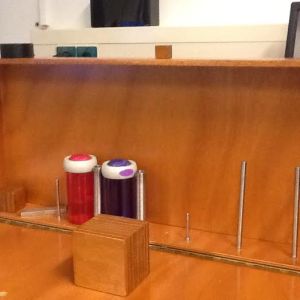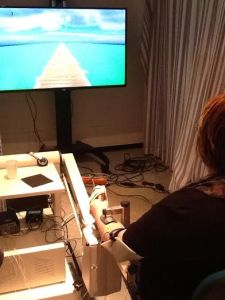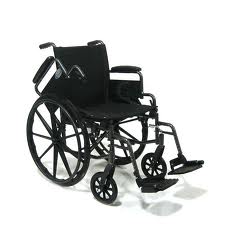Ever since I had my stroke, I have been offering myself as a guinea pig for scientific research. From day 1 I have given blood to analyze and been a test patient for students. In the rehab center I also participated in several research studies. This was quite satisfying as I felt at least someone was gaining some benefits from my disease and situation. It was something I could do, and only stroke patients could do. It made me feel useful. All this research had one theme in common: the effort for the patient was way too much. It took too long, and the researchers somehow hadn’t taken that into account,. Everything longer than 30-60 minutes (depending on the phase of the rehab a patient is in) is too much. Even from 30-60 minutes research time, a patient needs at least a day to recover. Last week I participated in the NEURAS research in the LUMC. I was invited at 9:30. a good time to start. First I had to go through the standard tests, used in rehab, to evaluate the level of the patient. This consisted of a questionnaire and several excercises, where little cubes had to be lifted and glasses of water had to be poored with my bad hand.  This took about 30 minutes. Then I was offered a cup of coffee (very important to keep your patients watered and fed), before I had to be strapped into the next research setting. I was connected to a robot and a computer. I had to ”drive” a virtual car while the robot did several things to my arm, in order to detect spasms and reactions of my muscles. I had to drive the car over different roads, and I could feel in the robot the effect of the structure of the road. While driving, I had to collect coins that were scattered over the road. It was a fun game. After that, tasks were added. I had to listen to a voice saying “high” and “low” at both a high and low tone. Sometimes the height of the tone did not correspond with the meaning. It was extremely difficult for me to focus on the auditory task while driving the car and trying to collect coins. In fact, I was not very good at it. Then an added difficulty was introduced. Some of the coins suddenly changed into different symbols, and those had to be avoided. It was at this task that my brain started to melt. I couldn’t do it, so my body decided to skip the ”high-low” task altogether, in order to leave some brainpower for the other tasks.
This took about 30 minutes. Then I was offered a cup of coffee (very important to keep your patients watered and fed), before I had to be strapped into the next research setting. I was connected to a robot and a computer. I had to ”drive” a virtual car while the robot did several things to my arm, in order to detect spasms and reactions of my muscles. I had to drive the car over different roads, and I could feel in the robot the effect of the structure of the road. While driving, I had to collect coins that were scattered over the road. It was a fun game. After that, tasks were added. I had to listen to a voice saying “high” and “low” at both a high and low tone. Sometimes the height of the tone did not correspond with the meaning. It was extremely difficult for me to focus on the auditory task while driving the car and trying to collect coins. In fact, I was not very good at it. Then an added difficulty was introduced. Some of the coins suddenly changed into different symbols, and those had to be avoided. It was at this task that my brain started to melt. I couldn’t do it, so my body decided to skip the ”high-low” task altogether, in order to leave some brainpower for the other tasks.  After an hour in total I announced I was getting tired. This was something I learned from my ergotherapist: at the first sign of tiredness, say something and prepare yourself to stop. People listened to what I was saying but wanted to finish this part of the research. I could relate to that, so I pushed myself to continue, in order to finish most of the research that was planned. After 1,5 hour I was getting exhausted. I announced that I needed to stop very soon, as I was almost collapsing on the spot. The researchers tried to motivate me to continue. What if I took a lunchbreak and continued afterwards? I told them I would be happy to return another day, but I could not continue that day. This caused some commotion on the researchers side, but we agreed to continue two weeks later. When I came home, I went straight to bed, slept for 3 hours, and had dinner. After dinner I fell asleep and slept until the next morning. The second day I stayed in bed while sleeping on and off. I just didn’t have the energy to walk. Today is the third day. I am out of bed, and will go to fitness in the afternoon. My husband stressed that I should make this known to anybody in research working with CVA patients (and maybe this applies to other neurological diseases as well). Everything that takes more than 1 hour is too long for a CVA patient. And even an hour may be too long, depending on the task ahead and the phase of recovery a patient is in. Researchers and professors, please take this into account when designing research. Go and visit a rehab center. Interview patients, nurses and therapists. They can enlighten you about the timespan you can use to conduct research.
After an hour in total I announced I was getting tired. This was something I learned from my ergotherapist: at the first sign of tiredness, say something and prepare yourself to stop. People listened to what I was saying but wanted to finish this part of the research. I could relate to that, so I pushed myself to continue, in order to finish most of the research that was planned. After 1,5 hour I was getting exhausted. I announced that I needed to stop very soon, as I was almost collapsing on the spot. The researchers tried to motivate me to continue. What if I took a lunchbreak and continued afterwards? I told them I would be happy to return another day, but I could not continue that day. This caused some commotion on the researchers side, but we agreed to continue two weeks later. When I came home, I went straight to bed, slept for 3 hours, and had dinner. After dinner I fell asleep and slept until the next morning. The second day I stayed in bed while sleeping on and off. I just didn’t have the energy to walk. Today is the third day. I am out of bed, and will go to fitness in the afternoon. My husband stressed that I should make this known to anybody in research working with CVA patients (and maybe this applies to other neurological diseases as well). Everything that takes more than 1 hour is too long for a CVA patient. And even an hour may be too long, depending on the task ahead and the phase of recovery a patient is in. Researchers and professors, please take this into account when designing research. Go and visit a rehab center. Interview patients, nurses and therapists. They can enlighten you about the timespan you can use to conduct research.
cva. memory loss
The transfer and the salsa
Since it was Queen’s Day, followed immediately by the weekend, my first four days were holidays. I had to rely mainly on nurses during this time to train and guide me. Afterwards, the nurses and therapists told me on numerous occasions, “Everything is therapy.”One of the first parts of this therapy I had to learn was “The Transfer.” When I thought of the word “transfer,” images of Schiphol airport, planes, hotels and holidays came to mind. Here it had a different meaning. The word “transfer” now meant between my wheelchair and something else. It seemed easy, and it was, for normal people. For people like me, though, it was a complicated operation. To start, I had to plan in my head what I had to do. Then I’d take the first and most simple step of calling the nurse to let down my bedrail. Someone that I didn’t know had already placed the wheelchair parallel to my bed with the brakes on and the chair facing me. I lowered the bed to the chair’s height, then turned my legs over the bed’s edge and sat up straight. This meant I had to drag my limp leg over the edge with my working arm. One doesn’t realize how heavy a limp leg is in reality. If it wasn’t for the nurse cheering me on and other natural powers forcing me to leave the bed, I would have fallen back in the pillows to sleep a bit more. As it was, I had to pause for a minute to rest and regain some strength. The nurse gave me a lot of instructions that went in one ear and out the other. First, I had to raise the wheelchair’s armrest. Next, I had to put my feet sideways of the floor. Then, my right hand was placed on the wheelchair’s armrest, while my left hand stayed on the bed for support. When my left hand bunched up into a fist, I was instructed to stretch it out flat. “Then wiggle your ass to the wheelchair,” the nurse said. “It’s just like the salsa.” My youngest daughter though this was hilarious. She imitated the nurse and got a lot of praise. It may have been the salsa to her or other people, but to me it was a chance to forget something: brakes on the chair, raise the armrest, feet in the right direction — very frustrating. The nurse would stand back and watch my attempts. She did this on purpose so I better learned what I had to do. As an educational psychologist, I recommend this approach in training. As a patient, however, I wanted to smack someone every time I forgot something. Especially when my youngest daughter added to the humiliation: “Look mom, it’s really easy! Just like the salsa!” The nurse helped me to educate my daughter. She was a cozy grandma, and my daughter really liked her. “Do you know how hard it is for your mom to go and sit down?” the nurse asked my daughter. “No,” she responded. “Go sit on the bed with your feet on the ground,” the nurse instructed. After my daughter complied, the nurse continued, “now lay down flat on your back on the bed.” The nurse stood with her legs against my daughter’s, then said, “try to sit up straight without the use of your hands.” That was a challenge for my daughter’s muscles. She managed to sit up, but her face was red and she moaned a lot. “Hard, wasn’t it?” the nurse asked. “For your mom it’s much harder.” My daughter looked at me with admiration. “When you wake up tomorrow,” the nurse continued, “try to realize how many muscles you use when you are getting up and out of your bed.” My daughter promised she would, then had to go home.
